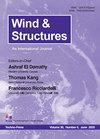Greenhouse Gas Savings Potential under Repowering of Onshore Wind Turbines and Climate Change: A Case Study from Germany
IF 1.9
4区 工程技术
Q3 CONSTRUCTION & BUILDING TECHNOLOGY
引用次数: 3
Abstract
Wind energy is crucial in German energy and climate strategies as it substitutes carbon-intensive fossil fuels and achieves substantial greenhouse gas (GHG) reductions. However, wind energy deployment currently faces several problems: low expansion rates, wind turbines at the end of their service life, or the end of remuneration. Repowering is a vital strategy to overcome these problems. This study investigates future annual GHG payback times and emission savings of repowered wind turbines. In total, 96 repowering scenarios covering a broad range of climatological, technical, economic, and political factors affecting wind energy output in 2025–2049 were studied. The results indicate that due to more giant wind turbines and geographical restrictions, the amount of repowerable sites is reduced significantly. Consequently, in most scenarios, emission savings will dramatically diminish compared to current savings. Even in the best-case scenario, the highest emission savings’ growth is at 11%. The most meaningful drivers of GHG payback time and emission savings are wind turbine type, geographical restrictions, and GHG emissions. In contrast, climate change impact on the wind resource is only marginal. Although repowering alone is insufficient for achieving climate targets, it is a substantial part of the wind energy strategy. It could be improved by the synergies of different measures presented in this study. The results emphasize that a massive expansion of wind energy is required to establish it as a cornerstone of the future energy mix.陆上风力发电和气候变化下的温室气体减排潜力:来自德国的案例研究
风能在德国的能源和气候战略中至关重要,因为它取代了碳密集型化石燃料,并实现了大量的温室气体(GHG)减排。然而,风能部署目前面临着几个问题:低膨胀率,风力涡轮机在其使用寿命结束,或结束报酬。重新供电是克服这些问题的重要策略。这项研究调查了未来每年的温室气体回收期和再生动力风力涡轮机的减排。共研究了96种再生能源方案,涵盖了影响2025-2049年风能产出的广泛气候、技术、经济和政治因素。结果表明,由于更多的大型风力涡轮机和地理限制,可再生站点的数量显着减少。因此,在大多数情况下,与目前的节省相比,排放节省将大大减少。即使在最好的情况下,最高的减排增长也只有11%。温室气体回收期和减排最重要的驱动因素是风力涡轮机类型、地理限制和温室气体排放。相比之下,气候变化对风力资源的影响微乎其微。虽然仅靠重新供电不足以实现气候目标,但它是风能战略的重要组成部分。可以通过本研究中提出的不同措施的协同作用来改善。研究结果强调,要使风能成为未来能源结构的基石,就需要大规模发展风能。
本文章由计算机程序翻译,如有差异,请以英文原文为准。
求助全文
约1分钟内获得全文
求助全文
来源期刊

Wind and Structures
工程技术-工程:土木
CiteScore
2.70
自引率
18.80%
发文量
0
审稿时长
>12 weeks
期刊介绍:
The WIND AND STRUCTURES, An International Journal, aims at: - Major publication channel for research in the general area of wind and structural engineering, - Wider distribution at more affordable subscription rates; - Faster reviewing and publication for manuscripts submitted.
The main theme of the Journal is the wind effects on structures. Areas covered by the journal include:
Wind loads and structural response,
Bluff-body aerodynamics,
Computational method,
Wind tunnel modeling,
Local wind environment,
Codes and regulations,
Wind effects on large scale structures.
 求助内容:
求助内容: 应助结果提醒方式:
应助结果提醒方式:


